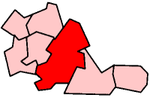

Austin Village is a First World War housing estate of prefabs between Longbridge and Northfield, Birmingham.
Herbert Austin, who created the Austin Motor Company at Longbridge in 1905, had to take on more workers during the First World War when his factory became involved in making tanks and aircraft. In 1917, he built a new estate for his employees in Turves Green on land bought for £7,750.[1] He imported 200 red cedar wood pre-fabricated bungalows from the Aladdin Company, Bay City, Michigan, USA.[1] They were shipped across the Atlantic and survived potential loss by U-boat attack. These were erected with twenty-five conventional brick-built semi-detached houses at intervals to create firebreaks.[1] They were fitted with coke-fired central heating, gas cooker, gas water boiler, sink and drainer, and a bathroom with bath.[2] The external size of the bungalows was 6.84 yards (6.25 m) wide by 11.75 yards (10.74 m) deep with an additional porch at the front and boiler room at the rear. The three bedrooms were each 9 feet 7 inches (2.92 m) square.[2] The brick houses were also fitted with two gas fires.[2]
Two octagonal children's shelters were built in the islands in Rowan and Laburnum Way but these have now gone.[2] Hawkesley Farm buildings were converted to a village hall and club room.[2]
Mature trees were planted along the roads: Central Avenue, Hawkesley Crescent, Hawkesley Drive, Coney Green Drive, Cypress Way, Cedar Way, Laburnum Way, Rowan Way and Maple Way. The village was completed in eleven months and rented to Austin workers with seven in each bungalow and twelve in each house.[1]
A wooden Baptist church (now demolished) was built opposite the north end of Central Avenue and an Anglican church (Church of the Epiphany, now gone) was built on the corner of the Oak Walk.[3]
After the war the requirement for workers reduced and the bungalows sold. The estate is now occupied and surrounded by conventional suburban housing. It forms the Austin Village Conservation Area.[4] Historic England has listed the conservation area on its Heritage at Risk Register due to its deterioration.
See also
References
- ^ a b c d Birmingham - The Building of a City, Joseph McKenna, Tempus Publishing Ltd. 2005, ISBN 0-7524-3489-6
- ^ a b c d e The Austin Village, Austin Village Preservation Society, 2002, ISBN 0-9541312-0-7
- ^ Austin Village Preservation Society, H. W. Mason, 1998
- ^ Birmingham City Council - Austin Village Conservation Area
External links
- Heritage at Risk Register: Austin+Village
- Austin Memories—History of Austin and Longbridge
- Austin Village Preservation Society - Online booklet
52°24′04″N 1°58′23″W / 52.401°N 1.973°W

